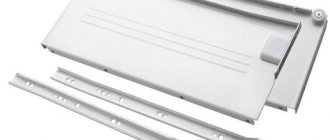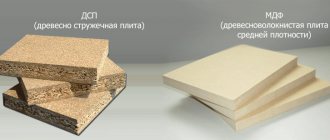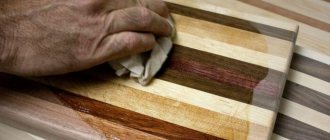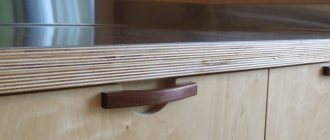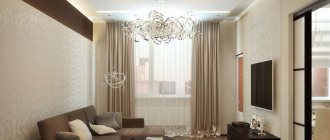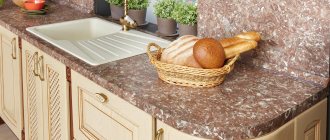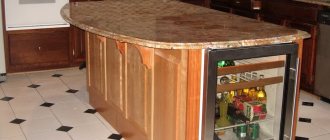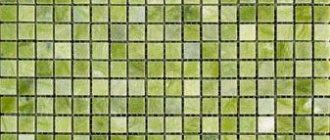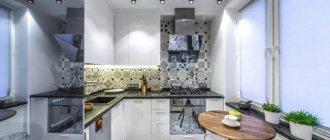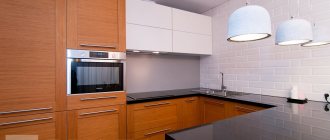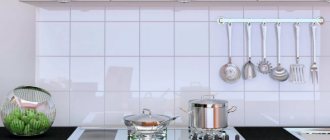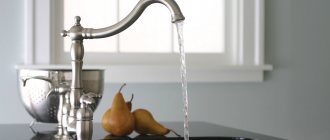Chipboard table top
To choose a chipboard countertop for the kitchen, let’s remember what it is. A kitchen worktop made of chipboard is a furniture production product that has specific characteristics related to the place of its use. You cannot take a standard chipboard furniture board and install it on the kitchen work surface in the form of a countertop. Moisture, elevated temperature, and frequent mechanical stress will very quickly render them unusable.
That is why the tabletop stands out as a separate product of furniture production with specific performance characteristics. For kitchen countertops, there are clearly furniture manufacturing trends that are common among the major countertop manufacturers. Let's talk about them.
Product detailing.
For convenience, we will create a table with notes.
Let's mark those ends of the parts that will need to be covered with an edge. If you need to glue both ends according to size “X” or “Y”, then we put two marks accordingly. If the part will be glued on all sides, then we put double marks for each of its sizes. In the same table, we will first calculate the area of the parts. This is necessary to determine the required amount of chipboard that will have to be purchased to assemble the table. We calculate in m2. For example: Table supports, 0.734 x 0.520 x 2 pieces = 0.7633. We round to three decimal places, always upward.
| Name | size X | size U | PC | Area, m2 | milling | |
| 1 | Table supports | 734 | | | 520 | 2 | 0,764 | without milling |
| 2 | Back wall | 828 | | | 360 | 1 | 0, 298 | without milling |
| 3 | Horizontal connections | 828 | | | 100 | 2 | 0,165 | without milling |
| 4 | Tabletop | 900 | | | 600 | | | 1 | 0,54 | 4 corners with a radius of 50 mm are milled. |
| 5 | Block stand | 470 | | 220 | | | 1 | 0,103 | mill 1 corner with a radius of 50 mm. |
| 6 | Stand support | 160 | 100 | | 1 | 0,016 | without milling |
| 7 | Keyboard shelf | 802 | | | 450 | 1 | 0,361 | without milling |
| 8 | Bumper | 800 | | | 60 | | | 1 | 0,048 | without milling |
| 9 | Superstructure cover | 420 | | | 220 | | | 1 | 0,092 | without milling |
| 10 | Superstructure support | 180 | 100 | | | 2 | 0,036 | without milling |
| Total area of parts: | 13 | 2,423 | ||||
As you can see, parts such as the table top, the superstructure cover, and the bumper are pasted over the entire perimeter, since all their ends are visible. Those ends of parts that join with others do not need to be pasted over. For example, the short ends of the ties and the back wall, which are structurally connected to the supports and are therefore not visible. Moreover, if these ends are pasted over, the linear size of the parts will change to the thickness of the edge and precise assembly of the table will not work. The lower end of the table leg (the upper end is connected to the tabletop), which is placed on the floor, we cover the supports of the stand or system unit as desired. Such ends are practically invisible. But it is worth noting that the edge protects the ends from mechanical stress and for some time from accidental moisture. Whether or not to paste over these ends is up to everyone to decide for themselves. It would be a good idea to paste it over, but if you really want to save a couple of tens of rubles, then nothing bad will happen either, because the add-on will stand on the tabletop, and we will screw furniture plastic bearings to the supports, so there will be no direct contact with the floor. In our example, I decided to save money.
But if the product is not made “for oneself”, but to order, then such ends must be pasted over without fail.
Let's calculate the required amount of edge. To do this, take the size of the side of the part and add 2-3 cm to it on each side. This reserve is necessary during gluing and is associated with the operation of edge banding equipment. If the side size is 800mm, then 800 +30 +30 = 860mm is the required piece of edge for it. The sides of the parts whose corners are rounded are considered to be straight, since in this case there will even be enough edges for the rounding. We count the edge in meters. For example: the amount of edge per leg end is 0.734 m + 0.06 m for reserve = 0.794 m.p. and so on.
The required amount of edge for the entire table = 18.84 m.p., rounded up to 19 m.p.
Edge
, which will be used to cover the table parts, ABS 2mm thick. The edge is glued on special edge banding equipment using hot melt adhesive at a temperature of 110 to 160 degrees. Such an edge is durable and reliably protects the end of the part, but although it is popularly called “shockproof”, it can withstand mechanical damage to a reasonable extent. It protects from moisture, but only if the contact with moisture was short-term. Sold by linear metres, the edge decor often matches the decor of laminated chipboard.
You can see how this machine works and how the edge is glued on it by downloading the video:
General design principle
To ensure the required characteristics of kitchen countertops, special materials are used in their designs.
The core is made of moisture-resistant chipboard.
Bottom surface : balancing kraft paper
The top surface of the countertops is usually:
- High pressure laminate (HPL or CPL)
- Laminated paper plastic (DBSP).
The leading edge is made of plastic if the panel has straight cuts;
The trailing edge is made of plastic.
A mandatory element of a high-quality countertop is a drip eliminator. This is a polyurethane element or chamfer at the transition of the top layer to the bottom.
Article on the topic: Kitchen corner: description, dimensions, materials, selection rules
Note: By design, the tabletop has four sides. Rear and leading edges, as well as two end parts.
What is the end part?
The end is the narrowest side of the object, which does not serve as the central facade. However, there are structures in which the entrance is located at the end. Vivid examples of this are: The Acropolis of Athens.
What does end mean?
intended for placement on the end, placing something on the end ◆ There is no example of use (see recommendations). adapted for processing a cross-section of something, for working on the end ◆ There is no example of use (see.
What is the end of a building?
We can say that the end of the building is the narrow side of the object, which does not serve as the main facade. However, you need to keep in mind that there are buildings in which the facade (main entrance) is located precisely on a narrow wall. Such buildings include the Manege, the Acropolis of Athens, and the Bolshoi Theater.
Rubble and bends in table tops
Kitchen worktops also differ in the design of the long sides (edges). Two parameters are involved here: hem and hem. The end without blockages has a straight cut (two “sharp” corners), the end with a blockage is semicircular. The term hem means that the shape of the edge is rounded.
The tabletop has two long sides, so based on the combinations of the arrangement of the blockages and folds on them, 5 tabletop options can be distinguished:
- No blockages (all ends are straight);
- 1 block (rounding): standard option for a kitchen worktop countertop standing against the wall;
- 2 blockages: a possible option for kitchen “islands”;
- 1 bend (rounding): a practical version of a standard tabletop. The technical parameter of the bend is its radius. The most common bend radius (postforming) is 9-10 mm at the top and 5 mm at the bottom;
- 2 bends: bend radius 9-10 mm at the top and 5 mm at the bottom.
Types of furniture edges: ABS, PVC, acrylic 3D, softforming and postforming
The main task of furniture edging is to cover the end surfaces of chipboard, but it also serves as a design element in finished cabinet furniture. In fact, there are quite a few types of edges that differ in material, method of fastening and price, and each has its own advantages and disadvantages. Let's look at all these points in more detail.
Types and features of furniture edges
In general, edges can be divided according to the following characteristics: Material
- Paper
- Plastic
- Metal (aluminum profile)
- 22 mm
- 28 mm
- 34 mm
- 38 mm
- Less often 45-55 mm
- Sometimes found up to 170 mm
- 0.4 mm
- 0.6 mm
- 1 mm
- 2 mm
- Generally there are from 0.2mm to 10mm
With or without glue (if without glue, then you need a machine to apply it) By type of fastening (rigid, overhead, mortise (U-shaped, T-shaped)) By type of surface (smooth, glossy, embossed, structured, colored and etc.) The most common (sorting in descending order) and used today are:
- PVC (1 and 2 mm thick, 22 and 34 mm wide, depending on the thickness of the slab)
- ABS (thickness from 0.4-2 mm)
- Melamine edge with paper backing (0.4-0.6 mm thick)
Melamine
This is a furniture edge made on a paper base and impregnated with melamine resins. They protect the base from external influences. Hence the name of the edge - melamine. Today it is the cheapest and most accessible, therefore it is very often used in furniture production, but to be honest, the quality of such furniture leaves much to be desired.
Tabletop ends (sides)
Typically, countertops are cut to fit the size of the kitchen, so the ends require additional protection after cutting. For chipboard countertops, there are three options for protecting the ends:
- Custom cutting at the factory with professional trimming (rolling);
- Use of special protective strips. An economical option that allows you to seal the ends of the tabletop at the installation site with your own hands;
- Apply the edge tape yourself.
In corner kitchens, it is necessary to join two panels of the countertop, creating a single work surface. Direct joining does not provide a proper connection and looks somewhat “clumsy”. Eurozapil corrects this problem.
What are the correct names for the sides of the house?
The word “butt” in Russian has several meanings.
In general terms, this is the name given to the transverse edge of an elongated object that has the shape of a cylinder or is a parallelepiped with right angles.
For cylindrical objects, the end is a face located perpendicular to the longitudinal axis. For rectangular parallelepiped objects, the end is the face with the smallest area.
The same word (“end”) refers to tiles made of wood and intended for paving streets. This word also has a slang meaning, denoting a person’s face. Almost everyone knows the expression “got it in the butt,” i.e. was beaten.
How to protect corners so children don't bump into them
Useful tips
A child grows up and constantly learns about the world. Every day he becomes more and more mobile and as soon as he begins to move independently, he can no longer be stopped. He needs to go everywhere, climb everywhere, touch, pull, feel and taste everything.
In every house there are many obstacles and dangers for a child - everywhere in his way there are protruding edges and corners of tables and stools, wardrobes and beds, interior intersections and turns. Banning something here is not a solution; it is up to the parents to provide all sharp corners and edges with protection so that children can have painless contact with them. Let's figure out what ways there are for this.
Protector pads
A simple and reliable way to make the outer corners of furniture safe is to apply special protectors with a rounded outer side to them. They are made of silicone, plastic or polyurethane foam, and therefore are soft, elastic and absorb all impacts well. They are attached to surfaces with an adhesive base and hold firmly - children cannot tear them off or bite them off. They come in transparent and a variety of colors, which allows you to match them to the style of any furniture.
To protect the “ribs” of tables and bedside tables, the ends of walls and door jambs, we glue a horseshoe-shaped strip of the same materials onto them. Covers for corners and “ribs” can be made with your own hands, for example, from thick rubber, heat-insulating materials with a sticky base.
Protective tape
Hard corners and edges of furniture can be easily softened by sealing them with double-sided tape with a special protective ribbed tape. Made from foam rubber. It is elastic and dense, very durable, adheres firmly to the surface, and is resistant to heavy loads. Cleans well. Available in different colors, it can be matched to any furniture and any interior.
Rubber border tape
The tape is used to apply a border to dangerous corners and “edges” of furniture, wall ends, etc. Made of rubber, soft and elastic, wide and thick, springs when pressed - ideal protection for babies from painful contact with hard and sharp surfaces.
Rubber tape is universal in installation, easily and reliably attached to surfaces of different configurations and different materials - wood and stone, glass and plastic. However, there is also a drawback - with its dimensions and appearance it may not fit into the sophisticated aesthetics of the room. But this is temporary until the children grow up.
Varieties
The front side of the building is called the facade; it is where guests are greeted. But it should be borne in mind that other sides of the building are also facades. However, they are not front, but side, back, and so on. All of them are divided by design features:
- Stone, brick.
- Concrete, monolithic.
- Translucent.
- Hinged ventilated structures. They differ in cladding. The cladding can be made of: porcelain stoneware, aluminum panels, fiber cement, metal cassettes, siding, blockhouse, decorative boards, stainless steel.
- Media façade. This is the most modern version of the front side of the building. In this case, screens are installed. Together, these screens form a video image. As a result, the front side of the building looks like one large screen. It looks very fashionable and modern.
conclusions
In the article I tried to show that choosing a chipboard countertop is not so easy. There are many parameters involved in the choice, and it is important to pay attention to everything when choosing. Also pay special attention to the protection of the ends and a high-quality joint, if any. But these are the nuances of its installation. What's in the following articles?
©Remont-Kuxni.ru
More articles
Similar articles
- 10 designer tips for organizing a comfortable kitchen: kitchen ergonomics
- Installing a worktop with a built-in hob and sink
- DIY kitchen plastering
- Table tops made of chipboard and MDF
- Connecting the hob and oven yourself
- 10 Videos on the use of world tile leveling systems
Related article: Stages of kitchen renovation: choosing a material for renovation How to choose a chipboard countertop for the kitchen: types of chipboard countertops Tags: hpl plastictype of countertopswork tablekitchen tabletop
